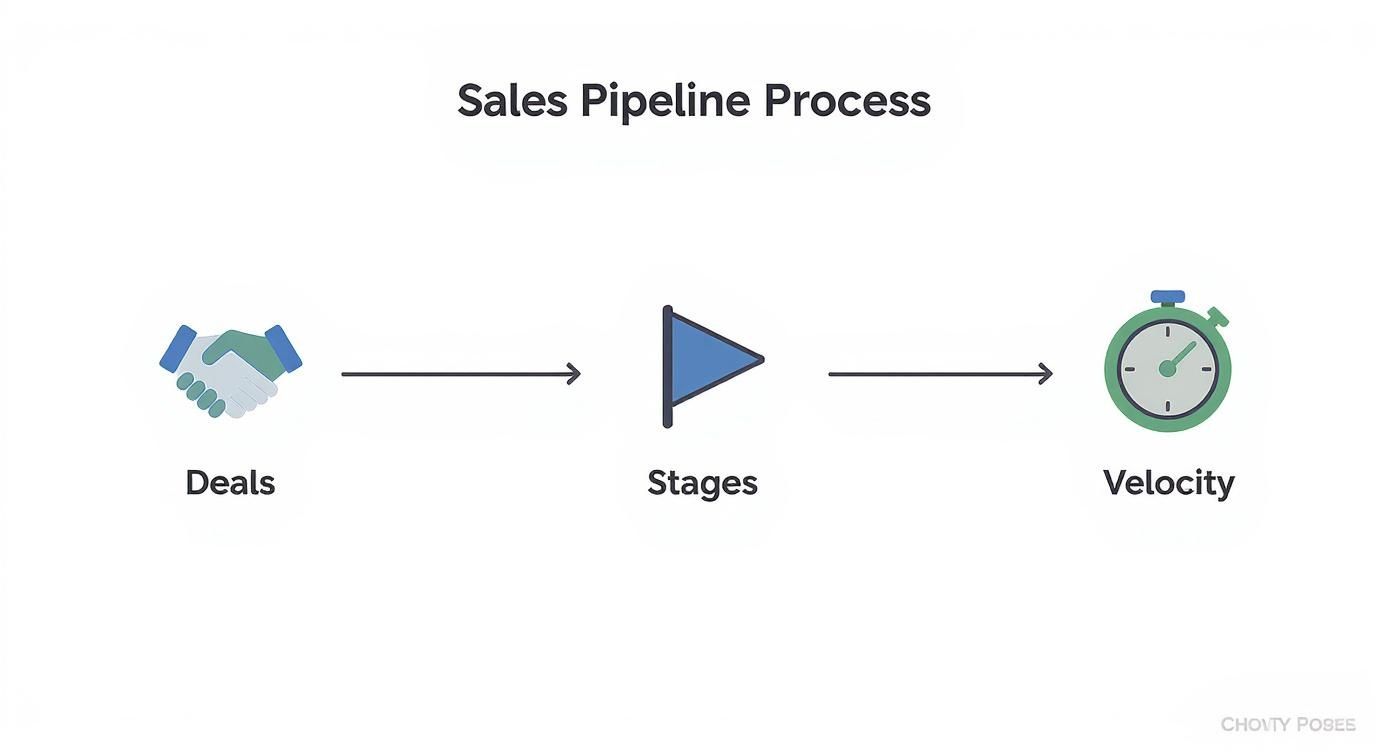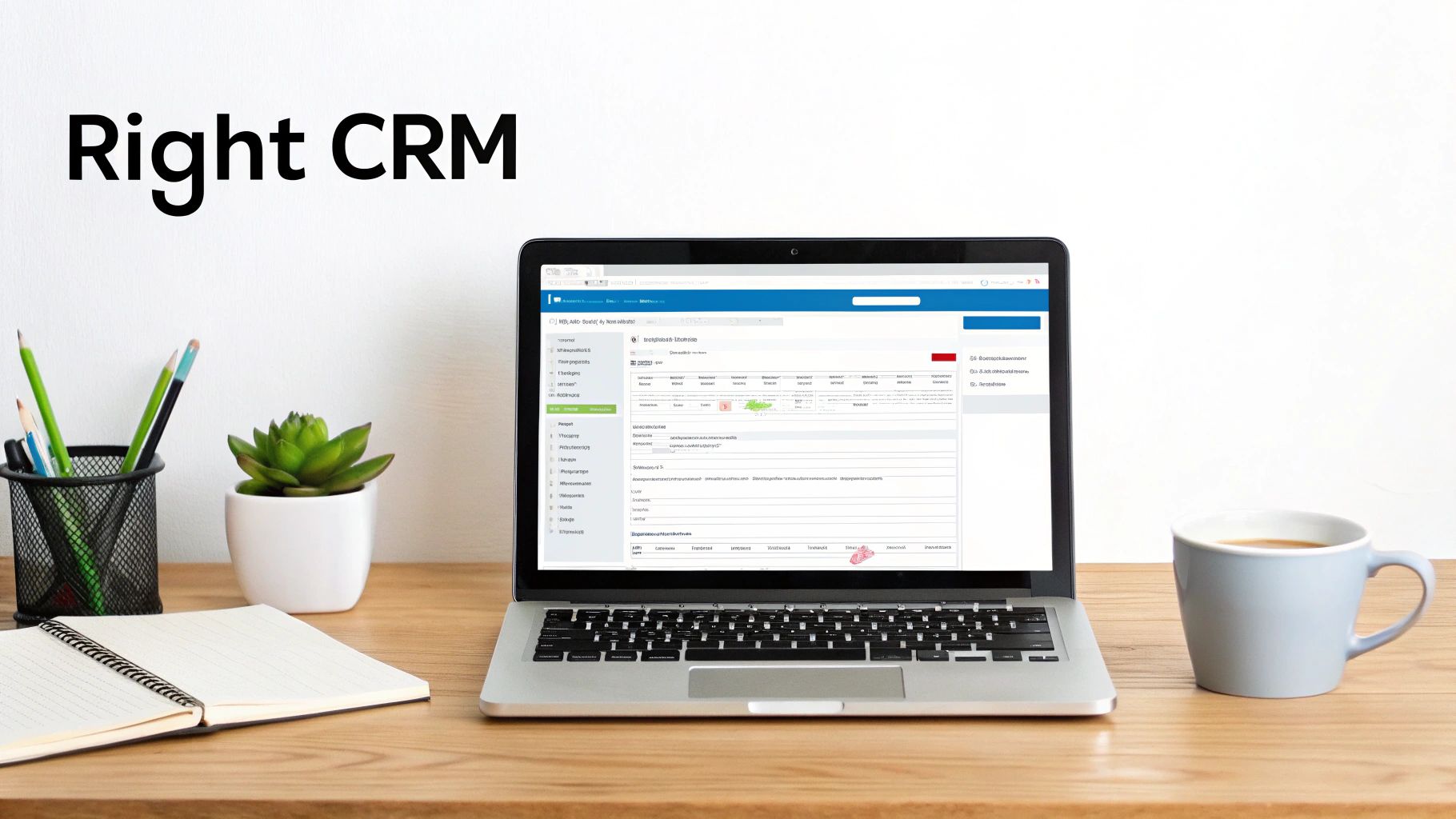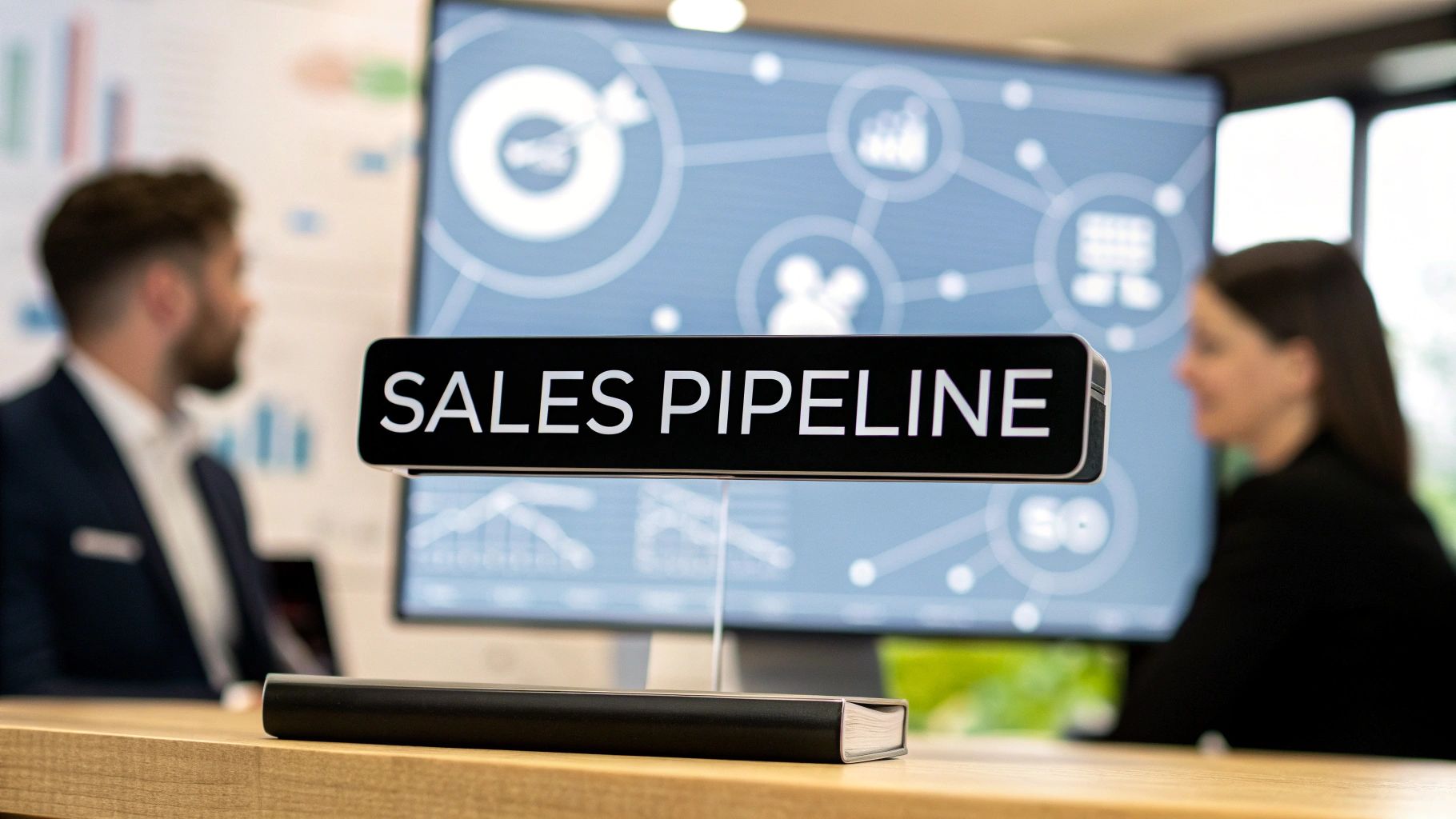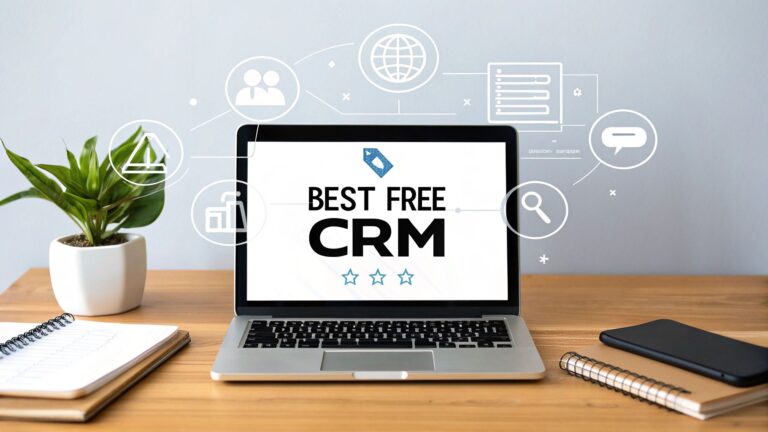What Is Sales Pipeline Management Explained
Picture your company's revenue goal as a destination on a map. Sales pipeline management is the turn-by-turn navigation that gets you there, transforming random sales activities into a clear, predictable path for turning prospects into paying customers.
Your Sales Pipeline Is Your Revenue Roadmap
At its heart, sales pipeline management is the practice of systematically tracking and guiding your sales opportunities as they travel from that first "hello" all the way to a closed deal. This isn't just about keeping a list; it's a proactive strategy. Instead of just reacting to wins and losses as they happen, you're in the driver's seat, steering potential customers through a journey you've already defined.
Think of it like an assembly line for making money. Each station on the line is a specific stage in your sales process—maybe "New Lead," "First Meeting," "Proposal Sent," and finally, "Deal Closed." Managing the pipeline means making sure that line keeps moving. You're constantly looking for bottlenecks, figuring out why certain deals get stuck, and making tweaks to keep everything flowing smoothly. This system pulls you out of messy spreadsheets and forgotten follow-ups and into a clear, actionable process.
The Core Components of Your Pipeline
To really get what sales pipeline management is all about, you have to know what it's made of. A few key elements work together to give you a complete picture of your sales health and what your revenue might look like down the road. They are the vital signs of your sales efforts.
A well-managed pipeline is the single most important predictor of future revenue. It helps you monitor deal flow, forecast performance, and prioritize your time around what matters most: turning opportunities into customers.
This isn't just about being tidy, either. It’s about building a foundation for serious growth. In fact, research from HubSpot shows that companies with effective pipeline management see a 28% higher revenue growth rate than those who don't. On the flip side, nearly half of underperforming companies have no defined sales process at all, which underscores just how critical this structure is. You can dig deeper into these kinds of insights on sales process efficiency from Salesgenie.
Let's break down the essential pieces that make up any healthy sales pipeline. Understanding these building blocks is the first step toward creating a true revenue-generating machine.
Here's a look at the fundamental elements you'll be working with.
Key Components of a Sales Pipeline
| Component | Description | Why It Matters |
|---|---|---|
| Deals | Individual opportunities or potential sales you are actively pursuing. Each deal represents a prospective customer. | Deals are the lifeblood of your revenue. Tracking them ensures that no potential sale ever falls through the cracks. |
| Stages | The distinct steps in your sales process that a deal moves through, like "Qualification" or "Proposal Sent." | Stages give you a high-level, visual snapshot of your entire sales cycle, letting you see where every deal is at a glance. |
| Velocity | The average time it takes for a deal to move from the first stage to the last (closed-won). | Velocity measures the speed and efficiency of your sales process. The faster your velocity, the faster you generate revenue. |
In short, your deals are the "what," the stages are the "where," and the velocity is the "how fast." When you get a handle on all three, you're no longer just selling—you're strategically managing your path to revenue.
Navigating the Essential Sales Pipeline Stages
Think of your sales pipeline less like a static to-do list and more like a roadmap. It’s the journey every potential customer takes with your company, and each stage is a critical milestone that brings a deal closer to the finish line. Getting these stages right is the bedrock of managing your pipeline effectively.
While the specifics can vary from business to business, most successful sales pipelines follow a similar, time-tested framework. This structure gives your sales team a clear playbook, so they always know the next right move. And it all starts with finding the right people.
Prospecting and Lead Generation
This is ground zero—the very top of your sales pipeline. Prospecting is all about actively identifying potential customers who match your ideal customer profile (ICP). It’s not just a numbers game of collecting names; it's about smart research and targeted outreach to find people who genuinely need what you're selling.
Leads can flow in from all over the place:
- Inbound Marketing: Think content downloads, webinar sign-ups, and people filling out your website's contact form.
- Outbound Sales: This is your team hitting the phones, sending personalized emails, and connecting on social media.
- Referrals: Nothing beats a warm introduction from a happy, existing customer.
The goal here is a healthy mix of quantity and quality. You’re essentially filling the top of the pipeline with promising opportunities for your team to start digging into.
Qualification and Discovery
Once a lead raises their hand and shows some interest, they move into the Qualification stage. This might be the single most important phase, acting as the bouncer for your entire pipeline. It's the "are we a good fit for each other?" conversation. Here, your reps do the detective work to see if this lead is a real opportunity worth the team's time and effort.
The point of qualification isn't just to sell—it's to decide if you should even try to sell. A well-qualified lead is far more likely to close, which stops your team from wasting energy on dead-end deals that just clog up the pipeline.
This is where you ask the tough questions about their budget, who has the authority to sign off, what their biggest pain points are, and their timeline for a decision. It's also your chance to connect your solution directly to their challenges. For prospects who seem like a good fit but just aren't ready to pull the trigger, this is the perfect moment to drop them into a nurturing sequence. To dig deeper, you can learn more about what is lead nurturing in our detailed guide.
This process flow shows how deals move through key stages, with velocity measuring the speed of that journey.

The visualization really drives home that a healthy pipeline isn’t just about having lots of deals; it's about moving them efficiently from one stage to the next.
Proposal and Closing
After you’ve confirmed a solid fit, the deal moves on to the Proposal stage. By now, you’ve had the discovery calls, you've run the demos, and you have a crystal-clear understanding of what the prospect needs. It's time to present a formal proposal or quote that spells out the scope, pricing, and terms. As you get closer to the finish line, knowing how to build effective sales pages can be a game-changer for getting deals signed.
The final stage is, of course, Closing. This is where the last negotiations happen, contracts are signed, and your prospect officially becomes a customer. A deal is marked as "Closed-Won" when they sign on the dotted line, or "Closed-Lost" if they decide to walk away. Don't just shrug off the losses, though—analyzing why you lost a deal at this final hurdle gives you incredibly valuable feedback to sharpen your entire sales process.
Unlocking Growth with Pipeline Management
Knowing your sales pipeline stages is a good start, but actively managing that pipeline is where the magic really happens. This is the difference between hoping for the best and building a predictable revenue machine.
Proper pipeline management sends ripples of clarity across your entire company. It transforms your sales process from a series of educated guesses into a reliable system for growth. You stop reacting to last quarter's numbers and start proactively shaping next quarter's success.
Think about it: instead of wondering why you missed your target, you can spot potential shortfalls weeks or even months ahead of time. That kind of foresight is a massive competitive advantage.
Achieve Shockingly Accurate Forecasts
One of the first and most powerful benefits of disciplined sales pipeline management is the ability to forecast revenue with real confidence. Once you know the total value of the deals in each stage and your historical win rates, predicting future income becomes surprisingly straightforward.
A clear pipeline is like a financial crystal ball for your business. It gives you a data-backed view of future revenue, so you can make smarter decisions about hiring, inventory, and strategic investments.
This isn't just for the C-suite, either. It helps sales managers set quotas that are ambitious but achievable. It also shows individual reps exactly what they need to close to hit their own targets, which is a huge motivator.
Boost Team Performance and Accountability
When everyone can see the pipeline, it naturally creates a culture of accountability. The status of every deal is out in the open, making it obvious who is crushing their goals and who might need a hand. Subjective opinions get replaced by hard data.
This transparency is a goldmine for coaching. A manager can easily spot a rep whose deals always seem to get stuck at the proposal stage and offer specific training to help them get over the hump. It also sparks healthy competition and encourages reps to share what’s working.
Ultimately, a well-managed pipeline helps you find and fix the hidden bottlenecks that silently kill deals. By seeing where things slow down or fall apart, you can address the root cause—whether it’s a clunky proposal template or a slow follow-up process. You smooth out the sales cycle, turning potential chaos into a streamlined engine for consistent growth.
Measuring the Health of Your Sales Pipeline
A sales pipeline without metrics is just a hopeful wish list. To turn that list into predictable revenue, you have to measure what matters. This is where tracking the right Key Performance Indicators (KPIs) comes in—they’re the vital signs that tell you the true health of your sales process.
Think of these numbers as the story of your sales efforts. They show you exactly where you're excelling and, more importantly, where things are breaking down.

It’s easy to get lost in a sea of data. The trick is to focus on a handful of high-impact metrics that give you clear, actionable insights. When you track these consistently, your pipeline transforms from a simple list of deals into a powerful tool for forecasting and planning your next move.
Essential Metrics to Keep an Eye On
To really understand what’s happening inside your pipeline, you need to look at it from a few different angles. These core metrics work together to give you the full picture—not just how many deals you have, but how valuable they are and how effectively your team is moving them toward the finish line.
-
Number of Qualified Leads: This is the fuel for your sales engine. Simply put, how many good-fit prospects are entering your pipeline each week or month? This helps you predict future sales volume. It's also the first checkpoint for quality; knowing how to spot a genuinely interested lead is a skill in itself, which is where understanding lead scoring best practices can make a huge difference.
-
Average Deal Size: How much is the average closed deal worth? This metric tells you if your team is landing the big fish or spending too much time on smaller, less profitable sales. A healthy pipeline usually has a good mix, but a consistently low average deal size might mean it's time to re-evaluate your targeting.
-
Conversion Rate (Win Rate): This one’s a classic for a reason. It's the percentage of your leads that actually become paying customers. You should track this for the pipeline as a whole, but the real magic happens when you track it stage-by-stage. If you see a big drop-off from the demo to the proposal stage, for example, you’ve just pinpointed a major weakness to fix.
Let’s Talk About Speed: Pipeline Velocity
If there's one metric that reveals the most, it's Deal Velocity. This measures how fast a deal moves through your pipeline, from the moment of first contact to the moment it's closed. Think of it as the speed of your revenue engine. The faster your velocity, the shorter your sales cycle and the quicker you get paid.
How to Calculate Deal Velocity:
(Number of Deals in Pipeline x Average Deal Size x Win Rate) / Length of Sales Cycle in Days
A sluggish velocity is a red flag. It often points to bottlenecks in your process—maybe proposals are taking too long to get out, or your follow-up game isn't creating enough urgency. By finding and fixing these friction points, you can speed up revenue without even needing to add more leads to the top of the funnel.
Keeping tabs on these metrics doesn't have to be a massive undertaking. The best sales teams look at them daily, weekly, and monthly. A quick check on how many Sales Qualified Leads (SQLs) were added, or the follow-up rate per rep, can tell you a lot.
Speed at the early stages matters immensely. For instance, data shows that responding to a new lead within an hour can increase your chance of converting them by nearly seven times. This is a perfect example of how small, prompt actions directly impact your pipeline's success. By consistently watching these numbers, you stop just managing deals and start strategically optimizing your entire sales process for growth.
Essential Sales Pipeline Metrics Compared
To help you decide which metrics to focus on, here's a quick comparison of the most critical KPIs. Each one offers a unique lens through which to view your sales performance.
| Metric | What It Measures | Indication of Success |
|---|---|---|
| Number of Qualified Leads | The volume of new, good-fit opportunities entering the pipeline. | A steady, predictable flow of leads each month. |
| Average Deal Size | The average monetary value of your closed-won deals. | An increasing or stable value, showing a focus on high-value clients. |
| Conversion Rate (Win Rate) | The percentage of leads that convert into paying customers. | A high and consistent percentage, especially at key stages. |
| Deal Velocity | The time it takes for a deal to move from start to finish. | A shorter sales cycle, indicating an efficient and streamlined process. |
Ultimately, these metrics are interconnected. A drop in qualified leads will eventually impact your win rate, and a slow deal velocity will drag down your revenue even if your average deal size is high. By monitoring them together, you gain a holistic view that empowers you to make smarter, data-driven decisions.
Choosing the Right Tools for Pipeline Management

Let's be honest: trying to manage a modern sales pipeline with spreadsheets is like trying to navigate a city with a hand-drawn map. It's possible, but you're setting yourself up for missed turns and painful delays. The right technology takes pipeline management from a tedious chore and makes it a genuine strategic advantage.
Today, a good Customer Relationship Management (CRM) system is the command center for any serious sales team. These platforms are built to organize your entire sales process in one place, giving everyone a single, reliable view of every deal in motion. The key is finding a tool that adapts to your sales process, not forcing your team to cram their workflow into clunky, ill-fitting software.
Core Features Your CRM Must Have
When you start looking at CRMs, it's easy to get lost in a sea of bells and whistles. Don't get distracted. Instead, zero in on the core functions that will actually help your team sell more efficiently.
Here are the non-negotiables:
- Visual Drag-and-Drop Pipeline: At a glance, your reps should see every single deal laid out across the sales stages. A Kanban-style board where they can simply drag an opportunity from one column to the next is intuitive and gives an instant snapshot of your pipeline's health.
- Workflow Automation: The best systems take the busywork off your team's plate. Think about it: automatically logging emails, creating follow-up tasks when a deal advances, or assigning leads. This frees up your reps to do what they do best—sell. To take this even further, look into dedicated business process automation tools that can plug right into your CRM.
- Insightful Analytics and Reporting: A great CRM doesn't just hold your data; it helps you make sense of it. You need customizable dashboards that track your most important metrics, from win rates to sales velocity. This is how you move from guessing to making smart, data-driven decisions.
Making the Right Choice for Your Team
There's no single "best" CRM for everyone. The right tool depends entirely on your team's size, your budget, and how complex your sales cycle is. A solo entrepreneur has completely different needs than a 50-person enterprise sales team.
For smaller teams and startups, a clean, straightforward system with the core pipeline features is usually the perfect starting point. As you scale, you'll likely need more advanced features like lead scoring, deep customization options, and a wide array of third-party integrations. For a side-by-side look at what's out there, check out our guide on the top sales pipeline management software.
The impact of choosing the right technology is immense. Organizations that adopt advanced CRM systems and automation see significant returns across the board.
The numbers speak for themselves. Using a robust CRM platform can increase sales by 29%, boost sales productivity by 34%, and improve forecast accuracy by an incredible 42%. Ultimately, the right tool should feel like a natural extension of your sales process, empowering your team to close more deals, faster.
Answering Your Top Sales Pipeline Questions
Alright, so we've covered the basics of what a sales pipeline is and why it matters. But as with anything in sales, the real learning happens when you start putting theory into practice. That’s usually when a few common questions pop up.
Let's clear up some of the frequent points of confusion I see teams struggle with. Getting these right can be the difference between a pipeline that fuels growth and one that just creates headaches.
Pipeline vs. Funnel: What's the Real Difference?
This is probably the most common mix-up. People use "pipeline" and "funnel" interchangeably, but they represent two very different perspectives on your customer's journey.
Think of the sales funnel as marketing's territory. It’s a bird's-eye view of the entire path from someone first hearing about your brand (awareness) all the way down to them becoming a customer. It's all about volume and conversion rates—how many people enter the top versus how many come out the bottom as buyers. It’s broad and often anonymous at the start.
A sales pipeline, however, belongs to the sales team. It’s a close-up, ground-level view of the specific, named deals you’re actively trying to close. It tracks the concrete steps a salesperson takes to move a qualified lead from "interested" to "signed contract." The funnel is about prospects; the pipeline is about opportunities.
How Often Should I Review My Pipeline?
The simple answer? Constantly. A sales pipeline is not a static document you create once and file away. It's a living, breathing tool that needs regular check-ins to be of any use. If your pipeline data is stale, your sales forecasts will be pure fantasy.
A healthy review rhythm usually looks something like this:
- Weekly: Every sales rep should be in their own pipeline, tidying things up. This means updating deal statuses, logging notes from that week's calls, and pushing out close dates where needed. It’s basic hygiene.
- Monthly: This is where sales managers step in. A monthly pipeline review meeting is crucial for spotting deals that are going cold, identifying where reps need coaching, and strategizing on how to get stuck opportunities moving again.
- Quarterly: At the leadership level, you’ll want to zoom out and look at the bigger picture. This is your chance to analyze high-level trends like win rates, the average deal size, and how long it takes to close a sale. These insights inform the strategy for the next quarter.
What Are the Most Common Pipeline Mistakes?
Even seasoned sales teams can fall into bad habits. The good news is that most pipeline problems aren't unique. If you know what to look for, you can avoid them.
The most dangerous pipeline mistake is treating it like a cluttered closet. If it's full of old, dead-end deals you're afraid to get rid of, you can't see the real opportunities that need your attention.
Keep an eye out for these three revenue-killers:
- A Clogged Pipeline: This is a classic. Reps hang onto deals that have gone completely silent, hoping for a miracle. This inflates your forecast with "hopium" and distracts from winnable opportunities. The fix: Be ruthless. Set clear rules for when a deal is officially dead and get it out of the active pipeline.
- Overly Complicated Stages: I've seen pipelines with a dozen or more stages. It sounds thorough, but in reality, it just confuses everyone and makes updating the CRM a chore nobody wants to do. The fix: Keep it simple. Stick to 4-7 core stages that mark real, meaningful progress from the buyer's perspective.
- Inconsistent Data Entry: When every rep updates their deals differently—or not at all—your pipeline becomes useless for forecasting. Garbage in, garbage out. The fix: Standardize what information needs to be captured at each stage and use CRM automation to log basic activities like emails and calls.
Steering clear of these traps is what true sales pipeline management is all about. It’s how you turn a simple tracking tool into a predictable roadmap for hitting your numbers.
Ready to build a sales process that avoids these common traps and drives predictable growth? The team at MakeAutomation specializes in creating automated, scalable systems that keep your pipeline clean and your team focused on what they do best—closing deals. Learn how we can help you optimize your sales engine.







